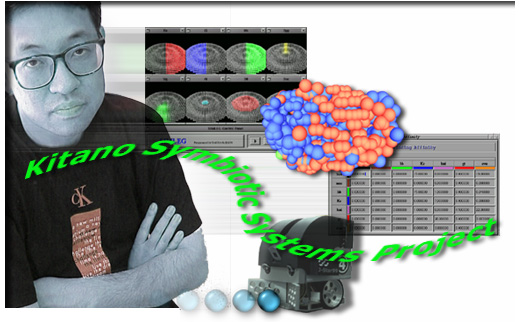 |
||||
|
|
 |
||||
|
|
| Symbiotic System refers to a class of systems consists of large numbers of elements each of which has diverse characteristics, and interacts selectively but in dynamic manner. The notion of diversity and selective interaction plays essential role in such systems. Biological systems are essentially heterogeneous and interactive systems, which entails above characteristics. The goal of this project is to establish a methodology for understanding such systems, as represented by biological systems at the level of gene regulations, metabolic pathways, neural systems, as well as high-level cognition, and to apply some insights obtained for engineering system designs. The project has two independent groups that share a common underlying motivation. These are: System Biology Group, and Symbiotic Intelligence Group Systems Biology group aims at establishment of a new field in biology, gSystems Biologyh. Systems Biology aims at system-level understanding of biological systems using the power of computation, analysis based on control theory and dynamical systems, new instrumentation technologies, which tightly coupled with experimental molecular biology. Understanding at system-level means that we can reproduce the system/phenomena on computer simulation or other medium, control their behaviors in the predictive fashion, and design such systems. As seen in the progress of the human genome project, the completion of DNA sequence of C. elegans in 1998, identification of components for biological systems is making a rapid progress. The use of DNA chip and micro-array made it possible for us to measure, although in a coarse-grain manner, behaviors of each gene in a large scale. In addition, there are numbers of efforts for systematic screening of various mutants for representative model systems. In the lights of such progress in molecular biology, we believe that time has come to venture into the system-level understanding of biological systems, based on understanding of individual components at molecular-level. In order to accomplish our goal, the initial stage of the project focuses on development of high fidelity simulation systems, large-scale parameter search based on expression and mutant data, hypotheses generation and verification, experimental design deduction, and apply such systems and methodologies for specific biological systems. We chose to investigate E. Coli, Yeast, C. elegans, drosophila, and certain aspects of human cells. In essence, we would like to find a method to gReverse Engineering Lifeh. Symbiotic Intelligence group focuses on high-level cognitive functions, and takes more synthetic approach to understand basic principles of intelligence reformulated in the engineering context. Consider how human learned to fly. Leonard da-Vinci, for example, tries to mimic wings and flipping motion of birds, and failed. The Wright Brothers discovered that the essence of flight is glifth and gthrusth, and created a fixed wing to generate lift when thrust is applied using an engine. The recent success of the IBMfs Deep Blue that beat human chess champion is decomposition of human intelligent ability during the chess game into memory and search. While the demonstrated success is limited to the chess, it may well be applicable for other highly intelligence tasks which shares essential aspects with chess. Symbiotic Intelligence group strive to find
the underlying principles of intelligence using high degree of freedom
robot systems with multiple perception channels, such as vision, auditory,
tactile, etc. We consider the integration of multi-modal perceptive
inputs combined with motor control to effects the environment and self
status is the basic conditions that exhibits intelligence. The concept
of streams of multiple perception channels and their association is
the other important premises. We have not clearly decomposed that are
essence in the engineering reformulation, as identification of such
concept is the final goal of the project. |

